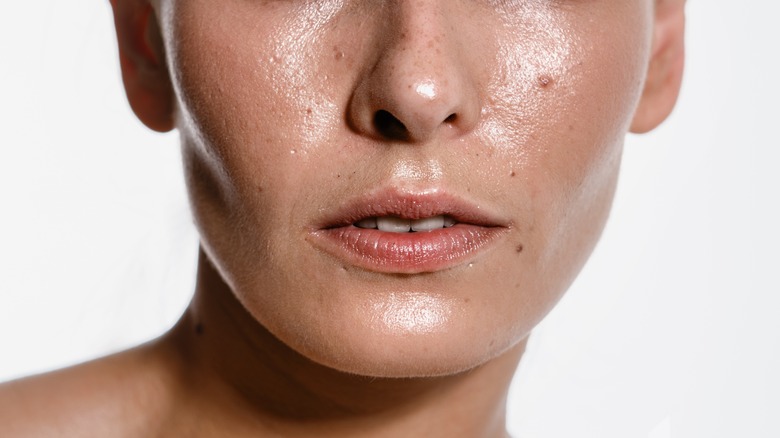Can Slugging Benefit Oily Skin? Here's What We Know
Slugging is a social media skincare fad involving coating the entire face in petroleum jelly. According to Dr. Amy Kassouf via Cleveland Clinic, "Petroleum jelly is a simple and very occlusive ointment," allowing it to create a hydration barrier on the skin. Oftentimes, those who practice the trend say they sleep with this barrier on their face in order to keep their hydrated glow. "Hydrated" is the key word. Most of the time, those who choose to use the slugging method are looking for benefits that involve moisturizing their dry skin.
As many of the benefits that come with slugging involve moisture, is it beneficial to try slugging if you have oily skin? The answer is yes, but only sometimes and in certain areas of the face. Other times, the cons outweigh any pros. All skin is different, so the benefits that slugging brings will vary from person to person. But if you are one of the few that have oily yet moisture-lacking skin, this trend could be the key to the hydration you have been looking for.
The benefits and risks of slugging to oily skin
While we most often hear of those with dry skin trying out the slugging method, the hydration it provides can sometimes be beneficial for those with oily skin as well. "The essence of the slugging trend is really all about keeping skin moisturized and a healthy skin barrier, and that's something anyone can benefit from regardless of their skin type," dermatologist Jenny Liu tells InStyle when speaking on slugging with oily skin. Slugging locks in moisturizing products while preventing moisture loss. While even those with oily skin need moisture to keep their skin truly hydrated, the method they use to get said moisture may need to vary from slugging.
While it is easy for those with oily skin to achieve the same hydration levels as those with normal or dry skin with the slugging method, there is one con that affects those with oily skin at a much higher rate. Oily skin is often acne-prone. If you have acne-prone or sensitive skin, occlusive ingredients are not often recommended for the face. Since petroleum jelly is occlusive, it creates a thick barrier trapping everything below it inside. If the slightest bit of dirt, oil, or makeup is left on the skin underneath the petroleum jelly, there is a good chance of a breakout forming.
How to slug on oily skin
If you choose to slug with oily skin, there are some steps that you should focus on more so than those with normal or dry skin. When choosing products to apply before applying the thin layer of petroleum jelly, ensure the products do not have alpha-hydroxy acids (AHAs), beta-hydroxy acids (BHAs), or retinoids, as these are active ingredients that can usually have a negative reaction with petroleum jelly. Instead, stick with other non-comedogenic and hydrating products.
For oily skin, dermatologist Jenny Liu tells InStyle that people should be extremely thorough in ensuring all dirt, oil, and makeup is removed from the face before applying the occlusive, to avoid breakouts. Also, consider trying the slugging technique on only the drier areas of the face, as these areas need a bit more hydration, whereas other areas are not so desperate.
The other steps of slugging with oily skin are the same as they are with normal to dry skin. Complete your chosen skincare routine and then apply a thin layer of petroleum jelly to the entire face or just a certain spot while your skin is still damp. You will then keep the petroleum jelly on your face overnight, washing it off in the morning for a hydrated and dewy glow.


